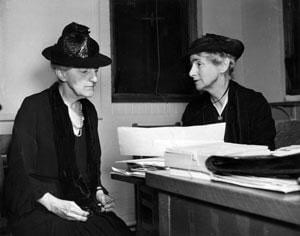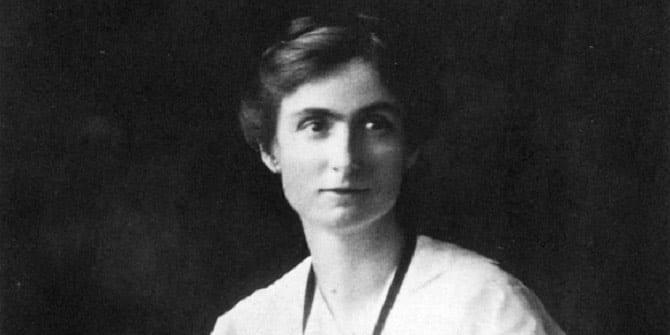By Caleb Weis ~
Edith Abbott was a pioneer in many ways, notable for her prolific sociological career, appointment as the first American female dean of a U.S. graduate school, and relentless commitment to using large-scale statistical surveys to inform policy recommendations and thereby enact broad societal change. This commitment resulted in a plethora of rigorous, in-depth publications, including The Delinquent Child and the Home, Truancy and Non-Attendance in the Chicago Schools, The Housing Problem in Chicago, Statistics Related to Crime in Chicago, and The Real Jail Problem of Chicago, written often in partnership with her University of Chicago undergraduate supervisor and subsequent colleague, Sophinisba Breckinridge. Her extensive contributions to this social reform-focused branch of sociology, however, were qualified by a need to continually reinforce and defend the academic value of such work, something that she fought hard to do throughout her lifetime, but which sometimes diminished the academic recognition which she received for such work. In this blog post, I will seek to broaden this recognition and increase awareness of Abbott herself by outlining her life, her most significant ideas, and her substantial contributions to sociological research and to the once-fledgling field of social work which she helped to grow.
Born in 1876 to a liberal-minded family (Hoffman 1) living on the frontier in Grand Island, Nebraska, Abbott was encouraged from a young age to “be independent and to follow intellectual pursuits” (Deegan 2). Her parents had both achieved considerable civic success in their lives: her father served for the Union in the Civil War and as the state of Nebraska’s first Lieutenant Governor, and her mother played an important role in numerous movements, including the movement for women’s higher education, the abolitionist movement, and the feminist movement, and they introduced civic involvement to the life of young Edith at the early age of six, when she was charged with sharing her bed with a campaigning Susan B. Anthony (Deegan 1, 2; Hoffman 1). Abbott also enjoyed excellent educational opportunities as an adolescent, attending Brownell Hall, a private girls’ high school, where she excelled academically, graduating with honors as valedictorian and the winner of a gold medal in recognition of her achievements (Deegan 2). Her childhood and adolescent educational opportunities and healthy family life were a testament to the not insignificant opportunities available to a woman at that time, and it is clear that she took full advantage of them.
Unfortunately, financial challenges ended up being the first to obstruct her path towards maximum academic achievement. Shortly after her graduation from high school, the bank at which her father was a director, Citizens National Bank, collapsed as a result of the economic depression of 1893, leading to the loss of the Abbott family’s financial reserves, and necessitating two years’ work as a high school teacher for Abbott in order to help her father pay off his debts (Deegan 2). Despite this challenge, Abbott continued to strive for her own academic development, completing correspondence courses during that period until she was able to fully enroll in the University of Nebraska in 1895 (Deegan 2). At that time, the University of Nebraska was flourishing as an intellectual institution, and Abbott exchanged ideas with sociologists E.A. Ross and Roscoe Pound, and linguist Lousie Pound, on her way to obtaining a degree in Economics. Her background in Economics certainly informed her later work, specifically such publications as The Tenements of Chicago, a study of the living conditions of the Chicago lower-class from 1908 to 1935, and Women in Industry, a comprehensive history of the wages and employment opportunities of women published in 1910. (She dedicated many of her early years as a sociologist to exploring the financial plight of women workers up until her period in history.)
However, it was her graduate study at the University of Chicago from 1903 to 1905 and a year-long fellowship at University College London and the London School of Economics in 1906 which more powerfully influenced her major research focuses as an academic, leading her to take a much stronger interest in affecting the lives of the poor through statistical work. While at Chicago, she earned her Ph.D. in political economy, and also made the professional acquaintance of Sophinisba Breckinridge. A prominent activist, social reformer, social scientist, and innovator in higher education, Breckinridge’s methods, sociological rigor, and deep care for the people whose lives she was working to change had a lasting impact on Edith Abbott, as is apparent from her memorial piece, Sophinisba Preston Breckinridge Over the Years. In London, in addition to her studies, Abbott lived in a settlement house, a residence for woman scholars housed in a poor neighborhood and purposed towards providing community aid through interactions with members of the community, meal supports, and community programs. There, she crossed paths with Sidney and Beatrice Webb, thinkers whose focuses on social reform and new ways to address poverty shaped Abbott’s own goals, as is evident from her later reference of their History of the Poor Law in her classes at the University of Chicago, during which time she was noted to have “spat out her horror at the long abuse of the poor” (Taylor 3). It was these experiences which most significantly shaped Abbott’s later work, prompting her to take a greater interest in how her research could make an impact on the least fortunate members of society, and steering her towards the field of social work because of its capacity to make an immediate difference in the world around her.

Edith Abbott (right) and Sophonisba Breckinridge (left). University of Chicago Photographic Archive, apf1-00008, Special Collections Research Center.
After these experiences, Abbott returned to the University of Chicago in 1908 to teach Statistics and to embark on an exceptionally productive academic career. During this time, she forged a prolific professional partnership with Breckinridge, publishing six seminal works in sociology in total and three with Breckinridge, including Women in Industry, The Tenements of Chicago, The Delinquent Child and the Home (1912), The Real Jail Problem in Chicago (1915), Statistics Related to Crime in Chicago (1915), and Truancy and Non-Attendance in the Chicago Schools (1917). It was in working on the latter four works––two of which were with Breckinridge––that her identity as a sociologist became most apparent, as these works were most firmly in the vein of the pragmatist sociological school of scholars, such as Jane Addams and her Hull House contemporaries. In these works, Abbott focused directly on how her research could inform policy decisions that could have an immediate impact on its subjects, concerning herself primarily with statistics and facts and striving to understand the intricacies of her research focuses in as efficient a way as possible.
For example, in The Delinquent Child and the Home, Abbott and Breckinridge decided to collect data on each and every arrested youth for the span of one year (July 1st, 1903 to June 30th, 1904), in order to gain a complete and yet contained snapshot of the individuals whom they sought to learn about (Delinquent 15). To collect this data, they used the most advanced sociological methods available to them, which included scouring police reports, visiting family homes, and interviewing probation officers, in order to obtain “all possible views of the court” (Delinquent 15). They then used the substantial data that they collected, such as the family situations, age, economic capacities, and truancy histories of each child, in order to sort them into three, often overlapping categories: dependents, who were arrested due to the lack of a stable family life or home; truants, who were arrested due to a failure to attend school; and delinquents, who were arrested due to their disregard for the law (Delinquent 11). It was practices like these which allowed Abbott to gain a nuanced and informed belief of the situations that she sought to study, which then gave her the academic backing necessary to make bold policy suggestions. For example, with regard to the aforementioned work, one of Abbott’s and Breckinridge’s conclusions was that it was senseless to repeatedly arrest youth simply because they were homeless, or lacked sufficient finances, and thus proposed the establishment of public funds to facilitate the “boarding-out” of needy children to more opportunistic settings, as had been done “to great success” in Scotland and Massachusetts (Delinquent 9).
Fundamentally, Edith Abbott believed that social institutions should work in the ways that were intended at their inception, and she was willing to work exceptionally hard herself in order to ensure that they did. This goal, which came to define her working life, caused her to move away from traditional sociological research in favor of the more practical, impact-focused field of social work, a discipline which she thought could help to transform the country into one in which there would be “‘No glory or beauty or music or triumph or mirth if it be not good for the least of the sons of the earth’” (quoted from Jane Addams in her The Hull House of Jane Addams). Unfortunately, as a result of this change in focus, Abbott lost much of the recognition attached to the more academically respected overarching field of sociology. Despite her continued, substantial efforts to amend this double standard, which included the successful push to reformulate the Chicago School of Civics and Philanthropy, the professional school at UChicago where she worked, into a fully fledged academic graduate school called the University of Chicago Graduate School of Social Service Administration, and the establishment of a celebrated academic journal of social work entitled Social Service Review, she was unable to achieve widespread academic recognition outside of Chicago. This goal of this blog post is to continue her work, and to perhaps ever so slightly fulfill “the greatest aid toward social justice which this generation comprehends: the truth made public” (Delinquent 10).
About the author:
 Caleb Weis is a third-year Economics and Mathematics double major at the University of Chicago. Hailing from the small town of Fletcher, Vermont, he spent a year playing soccer competitively in Spain before matriculating as a first-year in 2018. Since his arrival on campus, he has been involved in a variety of service organizations and RSOs, including Maroon Tutor Match, the UChicago Peer Mentoring Program, ROTC, and the Environmental Research Group. He also took up boxing in his second year, and started a Socially-Distanced Spanish conversation group to help himself and his bilingual friends to get through the quarantine. In his free time, he loves to play intramural and pick-up sports with his friends, including especially soccer, tennis, and soccer tennis. He very much enjoyed writing this blog post about Edith Abbott, and hopes that it enhances the understanding of this incredible woman and of her legacy.
Caleb Weis is a third-year Economics and Mathematics double major at the University of Chicago. Hailing from the small town of Fletcher, Vermont, he spent a year playing soccer competitively in Spain before matriculating as a first-year in 2018. Since his arrival on campus, he has been involved in a variety of service organizations and RSOs, including Maroon Tutor Match, the UChicago Peer Mentoring Program, ROTC, and the Environmental Research Group. He also took up boxing in his second year, and started a Socially-Distanced Spanish conversation group to help himself and his bilingual friends to get through the quarantine. In his free time, he loves to play intramural and pick-up sports with his friends, including especially soccer, tennis, and soccer tennis. He very much enjoyed writing this blog post about Edith Abbott, and hopes that it enhances the understanding of this incredible woman and of her legacy.
References:
Abbott, Edith. “Sophinisba Breckinridge Over the Years.” Social Service Review 22, no. 4 (1948): 417-423.
Abbott, Edith. “The Hull House of Jane Addams.” Social Service Review (1952): 334-338.
Breckinridge, Sophinisba and Edith Abbott. The Delinquent Child and the Home. Chicago: The
Russell Sage Foundation, 1919.
Deegan, Mary Jo, and Michael R. Hill. “Edith Abbott (1876-1957).”
DigitalCommons@University of Nebraska – Lincoln. 1991. https://core.ac.uk/download/
pdf/188110312.pdf.
Hoffman, Shari Cole. “Women in History—Grace Abbott: A Leader in Social Reform.” ResearchGate (2006).
Sorensen, John. “Edith Abbott (1876-1957) – Social Reformer, Author, Administrator and
Educator.” VCU Libraries Social Welfare History Project. 13 December 2010. https://
socialwelfare.library.vcu.edu/people/abbott-edith/.
Taylor, Eleanor K. “The Edith Abbott I Knew.” Journal of the Illinois State Historical Society
(1908-1984) 70, no. 3 (1977): 178-84. Accessed December 7, 2020. http://www.jstor.org/
stable/40191069.

